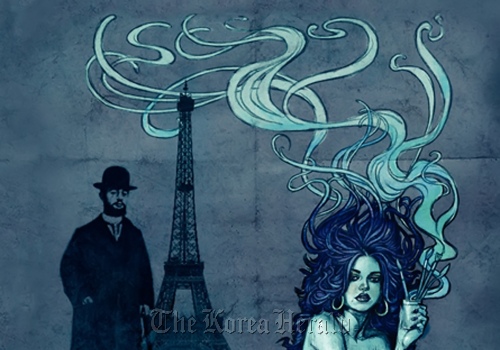Christopher Moore’s new novel blends diligently researched art history smoothly with his fevered, fiendish imagination. So smoothly, in fact, that you must never, ever give this book to a docent who gives museum tours.
But do give “Sacre Bleu” to anyone who likes tales of the Impressionists ― especially comic, down-and-dirty ones.
Moore starts from real points ― the prevalence of blue in the Impressionists’ paintings, and unexplained questions about the death of Vincent Van Gogh. He then spins a story of Bleu, a centuries-old muse who inspires painters, and the twisted Colorman, a nasty little shaman who creates the tubes of magical ultramarine that painters use in their greatest paintings.
 |
An image used for the cover of Christopher Moore’s new novel “Sacre Bleu.” (MCT) |
Bleu, the Colorman, the painters and their works are intertwined in a cycle of inspiration, passion, creation and suffering that frequently ends badly for the artists. I can’t remember another novel with so many syphilis jokes.
Moore opens with Van Gogh’s final day but soon jumps to the novel’s true heroes, the fictional but entirely plausible baker and wannabe painter, Lucien Lessard, and his friend, the real and entirely dissolute artist Henri de Toulouse-Lautrec. Along the way, he brings on other familiar artists, including Pierre-Auguste Renoir, Edouard Manet, James Whistler, Paul Gauguin, Georges Seurat and so on, many of whom have their encounters with Bleu.
Moore sprinkles reproductions of their real artworks into the book, and stories of the conception of those works into his novel, adding cheeky captions to the paintings. Of the nude woman in Manet’s “Le Dejeuner sur l’herbe,” a character remarks, “Looks to me like she’s deciding which of these two she’s going to bonk in the bushes.”
To our amusement, Moore’s artists aren’t any more reverent with each other. Manet, entering a salon and seeing his American friend Whistler, calls out, “How’s your mother?”
The kindhearted Lessard and the unabashedly rakish Toulouse-Lautrec make fine buddies and finer comedy, with Lessard frequently interrupting the artist in a brothel to pull him back into the plot. After Lessard nearly succumbs to a disaster, he wakes up to find Toulouse-Lautrec among the anxious at his bedside:
“‘Good God, Henri, is that smell coming from you?’
“‘I was going to come right over as soon as I heard you were awake, but the girls insisted upon giving me a bath first. I sat vigil for you for a week, my friend.’
“‘One sits vigil over the dying, not ten blocks away, on a pile of whores, out of his mind on opium and absinthe.’
“‘Each grieves in his own way, Lucien.”’
The Montmartre painters who had dealings with Bleu all have suffered memory lapses, leading Doctor Gachet, who also treated Van Gogh, to lecture Lessard and Toulouse-Lautrec on the dangers of their raw materials:
“You know that oil colors can contain chemicals that can harm you? The mercury in vermilion alone could drive a man to what is called the ‘hatter’s madness.’ We all know someone who has been poisoned by lead white. Chrome from chrome yellow, cadmium, arsenic, all elements of the colors you use.”
But the Colorman’s ultramarine is the most toxic color of all. As Lessard and Toulouse-Lautrec strive to unravel the Van Gogh mystery and end their own confusions, they face an ancient, formidable antagonist whose favorite happy endings include a dead painter.
By Jim Higgins
(Milwaukee Journal Sentinel)
(MCT Information Services)








![[Weekender] Korea's traditional sauce culture gains global recognition](http://res.heraldm.com/phpwas/restmb_idxmake.php?idx=644&simg=/content/image/2024/11/21/20241121050153_0.jpg)